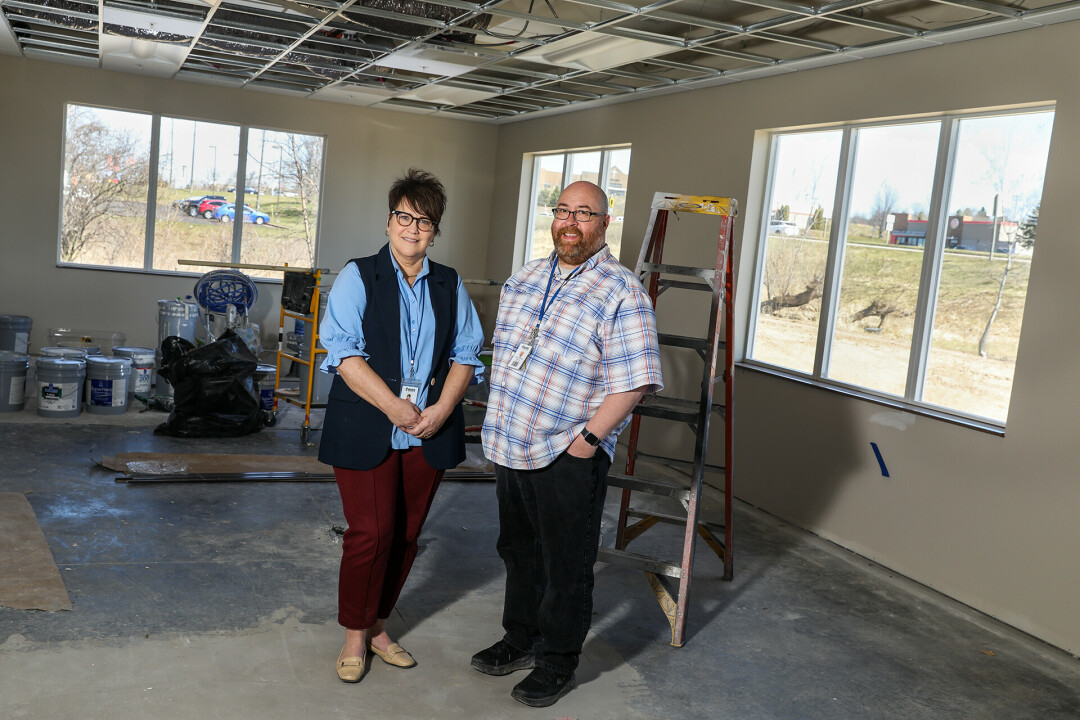LEARNING TO HOPE: Work Nears Completion on Hope Gospel’s New Learning Center
education facility will offer three times the space for the shelter’s residents
Tom Giffey, photos by Andrea Paulseth |

Eau Claire’s Hope Gospel Mission plans to open a new learning center this summer, a move it says will triple the available space for education, training, and counseling programs for residents experiencing homelessness and addiction who are served by the Christian nonprofit.
Among other things, the new 8,900-square-foot building will offer facilities for 60 computer workstations, as well as meeting rooms and classrooms for counseling and skills training. It’s now under construction next to Hope Gospel Mission’s main building, 2650 Mercantile Drive, just off North Clairemont Avenue.
The proximity to Hope Gospel’s short- and long-term shelter facilities, which typically house 40 to 50 men and women, is just one of the benefits of the new $1.8 million building, staffers say.
“This will give us a campus feel,” said Brett Geboy, Hope’s community relations director. “It will save time and money.” That’s because the current 3,000-square-foot learning center is located 5 miles away next to Building Hope, a building material store at 2108 Western Ave. This requires residents to be shuttled to and from the other side of town in passenger vans, which eats up an estimated 4,000 hours of potential programming time annually.
“I’m most excited that our residents will have an experience that reflects their worthiness to be invested in.”
CHRIS HEDLUND
HOPE GOSPEL MISSION PROGRAM DIRECTOR
The new learning center is a key part of Hope Gospel Mission’s approach to working with the homeless population, said Geboy and Chris Hedlund, Hope’s program director. Rather than merely providing overnight shelter and meals, Hope Gospel Mission is focused on long-term solutions to the problems of its clients, more than 90% of whom experience addiction. Those accepted into the long-term Renewed Hope residential recovery program are typically part of it for 18 months. After that, they may graduate to a transition program also housed on the site.
Hedlund said the new learning center will serve multiple purposes. It will provide client intake space where individuals begin the interview process to see if they are candidates for the long-term Renewed Hope program. Residents will also meet with counselors and chaplains in the new space. It will house 60 computer workstations, providing plenty of room for residents to work on their individualized “renewal plans,” which include work on everything from academics and finances to addictions, mental health, parenting, spirituality, and vocational training, Hedlund said.

Participants in the Renewed Hope program spend about half their day getting work readiness training at the Hope Gospel Thrift Center and half their day at the learning center. The current learning center is inadequate, Hedlund explained: There aren’t enough workstations for program participants, there isn’t enough confidential counseling space, and 10 staff members must share seven offices.
“I’m most excited that our residents will have an experience that reflects their worthiness to be invested in, and the efficiency of services (both in the facility design and the location on our campus) will allow us to provide more and better services to our residents,” Hedlund said.
On a recent tour, the still-under-construction building was a hub of activity, filled with the sound of power tools and the smell of paint. In the coming weeks, a drop ceiling and carpet will be installed, and furniture will arrive in May with a goal of programming moving in by June 1.
The building is being built to accommodate about 80 residents and can be added on to in the future if needed.
About 80% of the building’s total cost of $1.8 million has been raised, but help is still needed to finish the project. “We cannot help our neighbors and loved ones struggling with addiction, homelessness, and mental health needs without a supportive community,” said Sandi Polzin, the mission’s executive director.

Learn more about the Hope Learning Center project at hopegospelmission.org/hopelearningcenter.






















